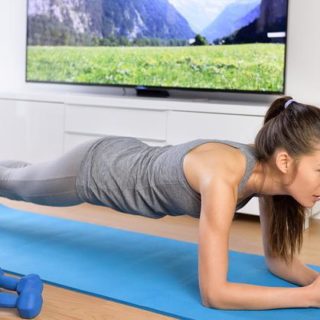Staying Healthy and Active While at Home
Physical health is essential to combat the stress and demands of today’s climate, but it can be difficult to stay healthy when access to public recreational facilities and gyms are limited. However, it’s more important than ever to maintain a healthy lifestyle, even as many of us are spending more time indoors. Below are a few tips to help you stay active while at home.
Ease into a routine.
Not only should your workout be safe and effective, but it should be enjoyable. It can be as simple as walking around the house, stationary jogging on a machine, jumping rope or sets of burpees. For those who don’t normally exercise, it’s best to ease into the routine with a low intensity workout, such as walking. As your body gets used to the physical activity, gradually increase the duration, intensity and frequency of the exercise. The overall goal should be moderately intense exercise for 30 minutes a day, five times a week.
Challenge yourself.
Missing the weight room at your local gym? You can always use your own body weight to target certain muscles with specific exercises. Wide push-ups work your chest muscles while narrow push-ups work your triceps. Squats and lunges tackle the lower extremities. Sit-ups, crunches and flutter kicks work on the abdominal muscles. Doing planks works on the core muscles. You can also take advantage of plenty of different workout programs available online – many are free, and they offer the guidance of a professional to ensure you’re not doing anything that could potentially result in injury.
Be mindful of what you eat.
Healthy eating is an integral part of preventing or managing medical illnesses and enjoying a good life. Eat recommended fruits, vegetables, grains, proteins and dairy for a well-balanced diet. Fats and oils are also part of a good diet but saturated and trans fats should be limited as these ingredients have been linked to heart disease, diabetes, some cancers and arthritis. Don’t worry, though. You can still sneak in snacks at home, so long as you choose healthy options, such as fruits and vegetables, whole grain foods and low-fat dairy products. However, if you have further dietary concerns, you should always discuss it with your healthcare professional.
Reduce triggers of stress and anxiety.
Remember to step away from your screen and take breaks from watching the news. Not only does this help relieve stress on your eyes, but it allows you to reduce your anxiety. Especially if your work involves looking at screens for prolonged periods of time, practicing the 20-20-20 rule is recommended: look at least 20 feet away for 20 seconds every 20 minutes. Pursue hobbies that you love and are shown to reduce anxiety, including meditation and yoga. Staying in touch with family and friends through phone calls and texts can also help calm us if we’re feeling uneasy.
Remember best practices.
It is equally important to adhere to best practices to stay safe amid the COVID-19 outbreak. This includes practicing physical distancing, washing your hands with soap and water often, and wearing cloth face coverings when out in public to help slow or prevent the spread of the virus. Check with the CDC and your local public health officials for the most up-to-date information and guidelines.



Leave a Reply